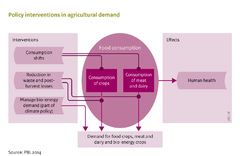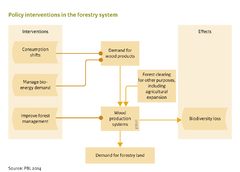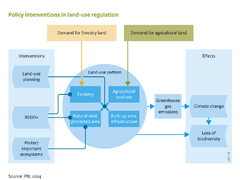Land and biodiversity policies: Difference between revisions
Jump to navigation
Jump to search
No edit summary |
m (Text replace - "Land and biodiversity policies/Targeting agricultural demand" to "Land and biodiversity policies/Agricultural demand") |
||
| Line 14: | Line 14: | ||
The interventions described in this section are implemented in different parts of the IMAGE 3.0 framework, and are also addressed in the components in which the respective processes are described. | The interventions described in this section are implemented in different parts of the IMAGE 3.0 framework, and are also addressed in the components in which the respective processes are described. | ||
Policies that change demand for agricultural products ([[Land and biodiversity policies/ | Policies that change demand for agricultural products ([[Land and biodiversity policies/Agricultural demand|agricultural demand part]]) are implemented in the agricultural economic model, thus taking into account the impacts on trade and demand in other regions. In IMAGE 3.0, change in wood demand is addressed in the model via a simple relationship with GDP, or by using external input data on wood demand (see Component [[Agricultural economy and forestry]]). Demand for second-generation bioenergy crops is addressed in the [[Energy supply and demand|energy model]]. | ||
Changes in production systems ([[Land and biodiversity policies/Targeting the agricultural production system|agricultural production system part]]) are modelled in IMAGE using alternative input parameters. For the relevant inputs in e.g. the [[Agricultural systems|land-use allocation]], [[Livestock|livestock]], and [[Nutrient balances|nutrient]] modules, these changes are consistent with those in the [[Agricultural economy and forestry|agro-economic]] model, to ensure appropriate representation of the (cost) structure of production. Production system changes, for example those induced by taxes or scarcity of endowments, are implemented in the agro-economic model and adjusted in other modules, accordingly. | Changes in production systems ([[Land and biodiversity policies/Targeting the agricultural production system|agricultural production system part]]) are modelled in IMAGE using alternative input parameters. For the relevant inputs in e.g. the [[Agricultural systems|land-use allocation]], [[Livestock|livestock]], and [[Nutrient balances|nutrient]] modules, these changes are consistent with those in the [[Agricultural economy and forestry|agro-economic]] model, to ensure appropriate representation of the (cost) structure of production. Production system changes, for example those induced by taxes or scarcity of endowments, are implemented in the agro-economic model and adjusted in other modules, accordingly. | ||
Revision as of 10:18, 16 May 2014
| Relevant overviews |
Key policy issues
- How can land-use policies contribute to strategies for halting biodiversity loss and reducing greenhouse gas emissions?
- How can changes in consumption patterns contribute to achieving sustainability goals through changes in land use?
- What are the synergies and trade-offs between halting biodiversity loss, food security, reducing nutrient emissions, and reducing water stress?
Introduction



